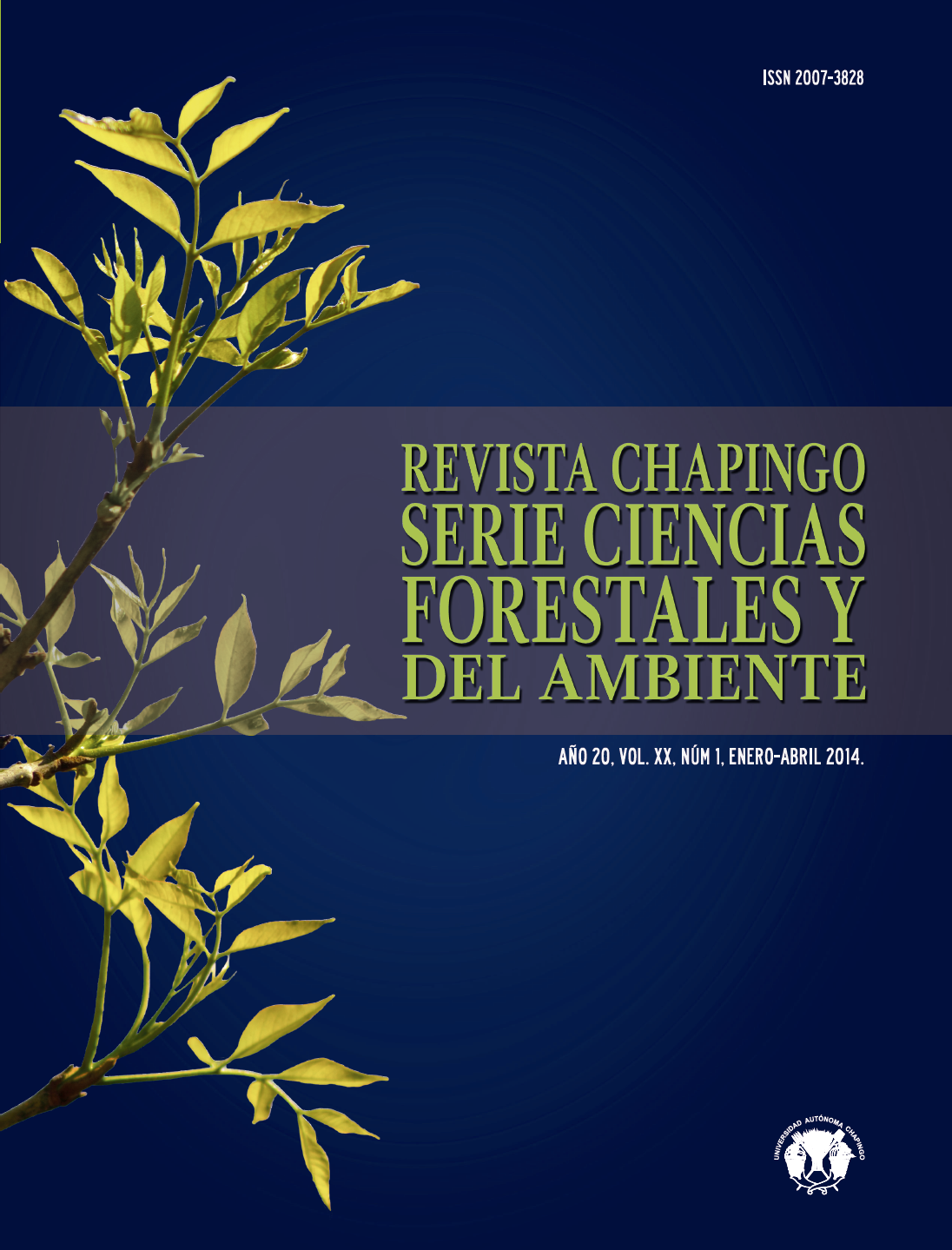Resumen
La industria forestal de la cabecera municipal Nuevo San Juan Parangaricutiro y de la Comunidad Indígena de Nuevo San Juan Parangaricutiro, Michoacán, México, generan 1,232 m3·año-1 de aserrín y viruta de pino que son subutilizados. El aserrín y la viruta de Pinus leiophylla Sch. Et Cham., P. montezumae Lamb. y P. pseudostrobus Lindl se analizaron fisicoquímicamente para determinar si reunían los requisitos para la elaboración de pélets y briquetas. El contenido de humedad, ceniza y elementos inorgánicos de los subproductos se determinaron según estándares internacionales. El contenido de humedad en aserrín fue 51.5 ± 1.9 % y 53.7 ± 0.1 % en viruta; estos valores superaron el máximo permisible. El contenido de cenizas en el aserrín y en la viruta fue 0.26 ± 0.03 % y 0.34 ± 0.03 %, respectivamente. En las tres especies evaluadas, el porcentaje medio de Ca, K, Mg, P, S, Si, Fe, Al y Na en el aserrín fue 47.1 ± 2.8, 26.0 ± 2.5, 13.5 ± 0.4, 5.0 ± 0.4, 3.2 ± 0.4, 2.3 ± 0.8, 1.0 ± 0.1, 1.3 ± 0.4 y 1.4 ± 0.3, respectivamente, mientras que el porcentaje medio de Ca, K, Mg, P, S, Si, Fe, Al y Na en la viruta fue 43.2 ± 7.0, 16.5 ± 3.0, 10.1 ± 4.8, 4.0 ± 0.6, 1.8 ± 0.2, 3.6 ± 0.3, 1.0 ± 0.6, 1.1 ± 0.1, y 1.0 ± 0.6, respectivamente. El arsénico sólo se encontró en la viruta (17.1 ± 17.1 %). De acuerdo con los resultados, el aserrín es el subproducto más adecuado para la producción de pélets y briquetas.
Citas
Agencia para Sustancias Tóxicas y el Registro de Enfermedades (ATSDR). (2007). Reseña toxicológica del arsénico. Atlanta, GA, EE. UU.: Departamento de Salud y Servicios Humanos de los EE. UU., Servicio de Salud Pública. http://www.atsdr.cdc.gov/es/toxfaqs/es_tfacts2.pdf
Bahng, M. K., Mukarakate, C., Robichaud, D. J., & Nimlos, M. R. (2009). Current technologies for analysis of biomass thermochemical processing: A review. Analytica Chimica Acta, 651(2), 117–138. doi: https://doi.org/10.1016/j.aca.2009.08.016
Campbell, A. G. (1990). Recycling and disposing of wood ash. TAPPI Journal, 73(9), 141–146.
De la Torre, E. Y. (2012). Los volcanes del Sistema Volcánico Transversal. Investigaciones Geográficas, Boletín del Instituto de Geografía, 50, 220–234. http://www.scielo.org.mx/pdf/igeo/n50/n50a18.pdf
Fengel, D., & Wegener, G. (1984). Wood chemistry, ultrastructure, reactions. Germany: Walter de Gruyter.
García, R., Pizarro, C., Lavín, A. G., & Bueno, J. L. (2012). Characterization of Spanish biomass wastes for energy use. Bioresource Technology, 103(1), 249–258. doi: https://doi.org/10.1016/j.biortech.2011.10.004
Granifo, R. A. (2009). Recuperación de los residuos de la madera para uso energético en la región metropolitana. Tesis, Universidad Andrés Bello, Santiago, Chile. http://www.chileresiduos.cl/chileresiduos/userfiles/file/tesis%20granifo%20residuos%20madera%281%29.pdf
Khan, B. I., Solo-Gabriele, H. M., Dubey, B. K., Townsend, T. G., & Cai, Y. (2004). Arsenic speciation of solvent-extracted leachate from new and weathered CCA-Treated wood. Environmental Science & Technology, 38(17), 4527–4534. doi: https://doi.org/10.1021/es049598r
Kuang, Y., Zhou, G., Wen, D., & Liu, S. (2007). Heavy metals in bark of Pinus massoniana (Lamb.) as an indicator of atmospheric deposition near a smeltery at Qujiang, China. Environmental Science and Pollution Research International, 14(4), 270–275. doi: https://doi.org/10.1065/espr2006.09.344
Lambert, M. J. (1981). Inorganic constituents in wood and bark of New South Wales forest tree species. Sydney, Australia: Forestry Commission of New South Wales.
Liu, X., & Bi, X. T. (2011). Removal of inorganic constituents from pine barks and switchgrass. Fuel Processing Technology, 92(7), 1273–1279. doi: https://doi.org/10.1016/j.fuproc.2011.01.016
Minitab Inc. (2010). Minitab statistical software. Minitab Release, 16.2.1. USA: Autor.
Miranda, M. T., Arranz, J. I., Rojas, S., & Montero, I. (2009). Energetic characterization of densified residues from Pyrenean oak forest. Fuel, 88(11), 2106–2112. doi: https://doi.org/10.1016/j.fuel.2009.05.015
Obernberger, I., & Thek, G. (2004). Physical characterisation and chemical composition of densified biomass fuels with regard to their combustion behaviour. Biomass and Bioenergy, 27(6), 653–669. doi: https://doi.org/10.1016/j.biombioe.2003.07.006
Obernberger, I., & Thek, G. (2010). The pellet handbook (1st ed.). London-Washington DC: Earthscan.
ÖNORM M 7135 (2000). Compressed wood or compressed bark in natural state-pellets and briquettes, requirements and test specifications. Vienna, Austria: Osterreichisches Normungsinstitut.
Revilla, G., E. (2011). Química de la madera de cuatro pinos mexicanos de la subsección Cembroides. Tesis, Universidad Autónoma Chapingo, Chapingo, Texcoco, Edo. de México, México.
Shapiro, S. S., & Wilk, M. B. (1965). An analysis of variance test for normality (complete samples). Biometrika, 52(3/4), 591– 611. http://sci2s.ugr.es/keel/pdf/algorithm/articulo/shapiro1965.pdf
SPSS (2009). PASW Statistics 18. Chicago, IL, USA: Autor.
Téllez, C., Ochoa, H. G., Sanjuan, R., & Rutiaga, J. G. (2010). Componentes químicos del duramen de Andira inermis (W. Wright) DC.(Leguminosae). Revista Chapingo Serie Ciencias Forestales y del Ambiente, 16(1), 87–93. doi: https://doi.org/10.5154/r.rchscfa.2099.11.046
UNE-EN 14774. (2010). Biocombustibles sólidos. Determinación del contenido de humedad. Método de secado en estufa. Parte 3. Humedad de la muestra para análisis general. Madrid, España: Asociación Española de Normalización y Certificación.
UNE-EN 14775. (2010). Biocombustibles sólidos. Método para la determinación del contenido en cenizas. Madrid, España: Asociación Española de Normalización y Certificación.
Van Lith, S. C., Alonso, V., Jensen, P. A., Frandsen, F. J., & Glarborg, P. (2006). Release to the gas phase of inorganic elements during wood combustion. Part 1: Development and evaluation of quantification methods. Energy & Fuels, 20(3), 964–978. doi: https://doi.org/10.1021/ef050131r
Vassilev, S. V., Baxter, D., Andersen, L. K., & Vassileva, C. G. (2010). An overview of the chemical composition of biomass. Fuel, 89(5), 913-933. doi: https://doi.org/10.1016/j.fuel.2009.10.022
Vassilev, S. V., Baxter, D., Andersen, L. K., Vassileva, C. G., & Morgan, T. J. (2012). An overview of the organic and inorganic phase composition of biomass. Fuel, 94, 1–33. doi: https://doi.org/10.1016/j.fuel.2011.09.030
Werkelin, J., Lindberg, D., Boström, D., Skrifvars, B. J., & Hupa, M. (2011). Ash-forming elements in four Scandinavian wood species part 3: Combustion of five spruce samples. Biomass and Bioenergy, 35, 725–733. doi: https://doi.org/10.1016/j.biombioe.2010.10.010
Werkelin, J., Skrifvars, B. J., Zevenhoven, M., Holmbom, B., & Hupa, M. (2010). Chemical forms of ash-forming elements in woody biomass fuels. Fuel, 89(2), 481–493. doi: https://doi.org/10.1016/j.fuel.2009.09.005

Esta obra está bajo una licencia internacional Creative Commons Atribución-NoComercial 4.0.
Derechos de autor 2014 Revista Chapingo Serie Ciencias Forestales y del Ambiente



